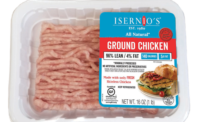Meat Science Review
MAP improves redness of dark-cutting beef

Consumers often associate a bright-red color with beef freshness and wholesomeness. Higher-than-normal-pH conditions are an example of a color deviation in which beef failed to have a bright-red color, leading to discounted carcasses and economic losses to the meat industry. High-pH beef or dark-cutting beef is one of the most prominent beef-quality defects worldwide. Dark-cutting beef is characterized by elevated muscle pH, increased water-holding capacity, a dry-sticky texture and an undesirable very dark lean color. The 2011 National Beef Quality Audit reported that 3.2 percent of carcasses graded were assessed as dark-cutting. Although the etiology of dark-cutting beef is not clear, it is widely accepted that pre-harvest stress leads to depletion of glycogen reserves prior to slaughter, which hinders the formation of lactic acid in postmortem muscle. The average postmortem muscle pH in normal beef ranges from 5.4 to 5.6 because of lactic acid formation. In dark-cutting beef, however, pH ranges from 6.0 to 6.8 because of limited lactic acid from glycogen.
Various factors such as the plane of nutrition, cattle temperament, climate variation, misuse of growth promotants/implants, mishandling practices and shipping are all potential contributors for dark-cutting carcasses. All these factors can affect stress and glycogen levels prior to animal harvest. In recent years, beef producers have optimized various factors such as feedlot management, good handling practices and proper transportation practices to minimize losses from dark-cutting beef. Still, dark-cutters continue to be a quality defect around the world. Therefore, understanding the fundamental basis of high-pH beef is critical to developing post-harvest strategies to improve color and value of high-pH beef.
Quality variations in meat, such as a higher pH than normal, are intimately and complexly related to the chemical and physical changes in muscle that occur ante- and postmortem. The etiology of rapid glycolytic rates early postmortem in carcass meat ranges from the pale, soft and exudative condition to dark, firm and dry or dark-cutting if the stressors are prolonged until near glycogen depletion. Most of these aberrant properties are related to two fundamental chemical events in meat, oxygen consumption (OC) and metmyoglobin-reducing activity (MRA). Muscle ultra-structure and biochemical properties vary between muscles with a normal vs. high-pH. Comparative methodologies only recently were developed to more accurately study MRA and OC in high-pH steaks under various processing and packaging conditions.
Several approaches have been used to improve the appearance of dark-cutting beef such as aging, lowering muscle pH by lactic acid enhancement and modified atmospheric packaging. For example, enhancing beef with lower levels of lactic acid improved redness of dark-cutting beef. Recently, researchers at Oklahoma State University have standardized a modified packaging and antioxidant enhancement technique that improved redness of dark-cutting beef (Figure 1). Dark-cutting steaks enhanced with an antioxidant solution and packaged in modified atmospheric packaging enhanced the redness by approximately 45 percent over non-enhanced dark-cutting steaks. Modified atmospheric packaging represents gas compositions within a package modified to improve red color. For example, modified atmospheric packaging (MAP) involves rigid trays and oxygen impermeable films. In a high-oxygen package (HiOx-MAP), the oxygen level is 80 percent (four times more oxygen than atmospheric conditions). A greater oxygen level can meet oxygen demand by myoglobin and promote bright-red oxymyoglobin formation. The FDA approved 0.4 percent carbon monoxide concentration for carbon monoxide MAP. Carbon monoxide can bind with myoglobin to form stable bright-red color similar to oxymyoglobin.
Extended aging decreased color stability of normal- and high-pH steaks packaged in PVC and HiOx-MAP. Greater oxidative conditions in the HiOx-MAP, in combination with longer aging time, decreased the redness of both normal and high-pH steaks compared with PVC. Utilization of CO-MAP can limit discoloration with extended aging for both in normal- and high-pH beef, provided there is strict cold-chain management. Use of appropriate myoglobin quantification methods are critical in determining biochemical properties of high-pH beef. Understanding the OC and MRA changes associated with aging can help beef processors to select packaging systems that will limit losses caused by oxidative discoloration. NP
* R. Ramanathan, A. R. English, G.G. Mafi and D.L. VanOverbeke are all from the Department of Animal and Food Sciences at Oklahoma State University, Stillwater. M.C. Hunt is from the Department of Animal Sciences and Industry at Kansas State University, in Manhattan. Contact corresponding author Ramanathan at ranjith.ramanathan@okstate.edu or 405-744-9260
Looking for a reprint of this article?
From high-res PDFs to custom plaques, order your copy today!





